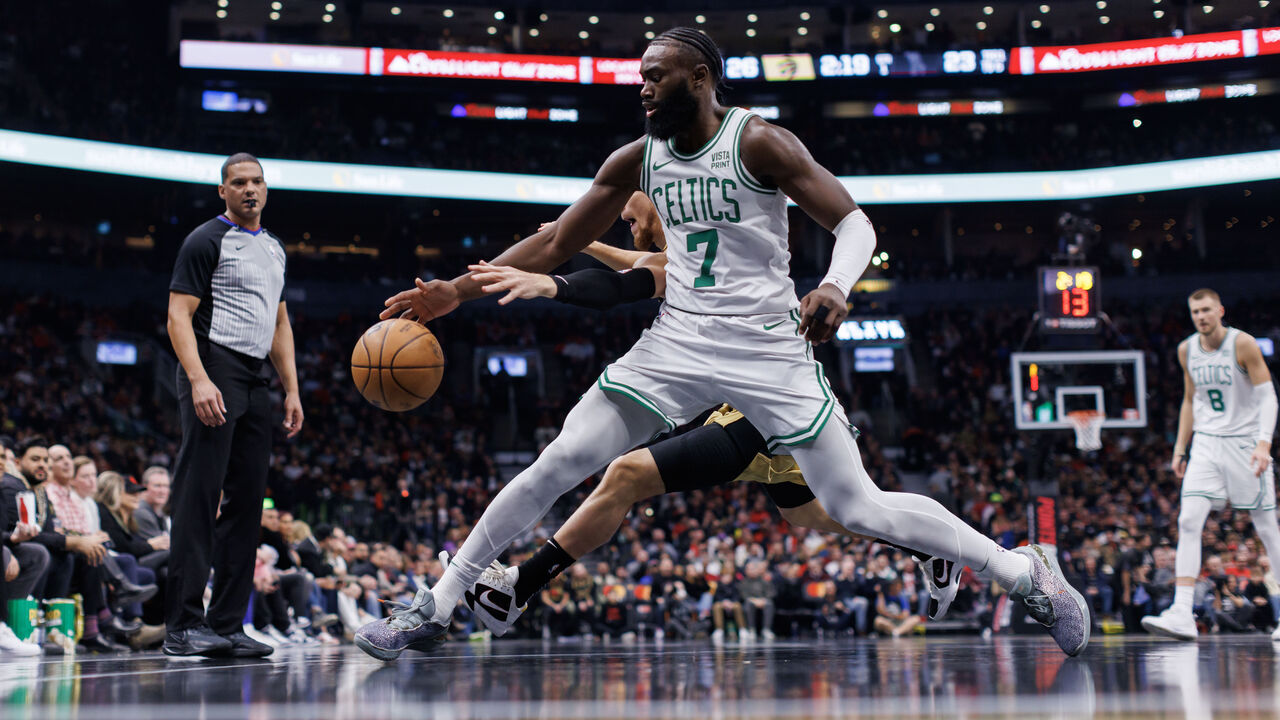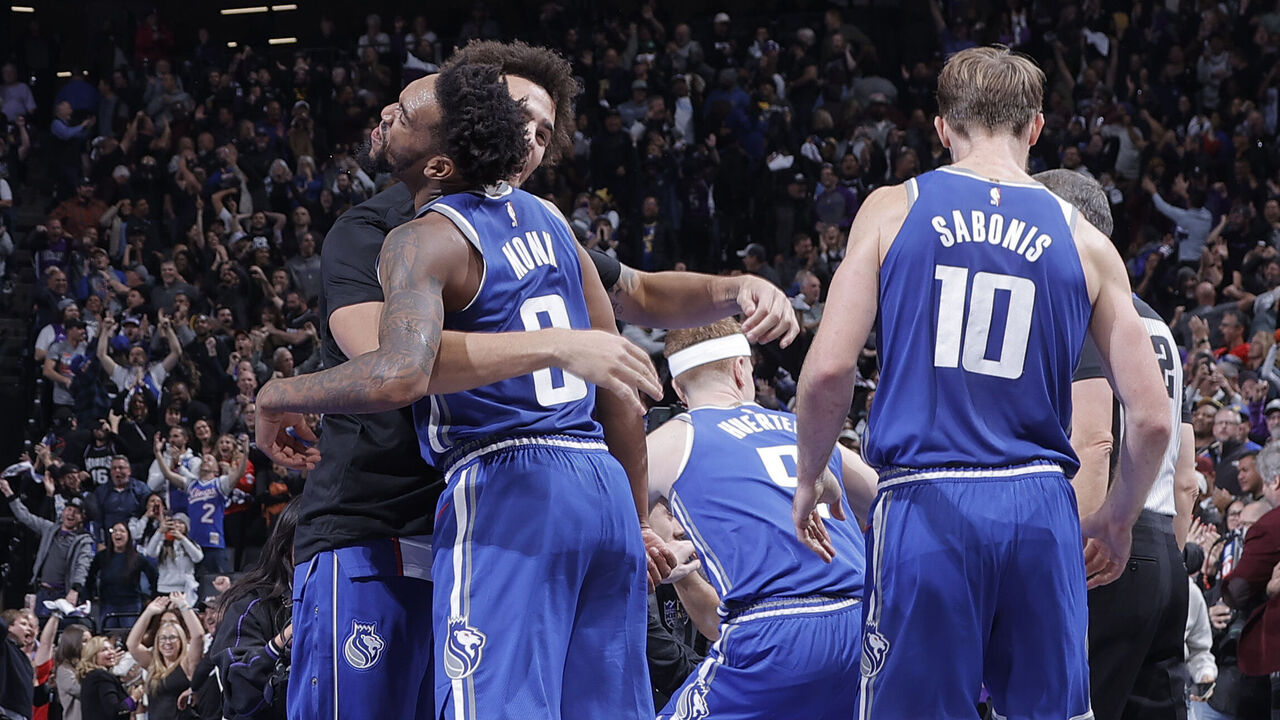'Our guys wanna win that Cup:' In-Season Tournament (mostly) a slam dunk
If the NBA was looking for an early-season jolt with the In-Season Tournament, then mission accomplished.
Stakes have never been higher so early on the schedule, and that’s something to celebrate. Of course, the inaugural NBA Cup was bound to have some hiccups, and there are still a couple of concerns worth addressing.
With group play giving way to the single-elimination knockout rounds, let’s dig into our first impressions of the competition.
A slam dunk

A gripping, eight-game Tuesday night had to be everything the league office dreamed of when it cooked up the idea for this tournament. A great evening of hoops saw teams, fans, and broadcasters watching scoreboards and tracking tiebreaker permutations on a random weeknight in November. An instant classic between the Warriors and Kings – which also served as a postseason rematch – provided the evening’s thrilling finale.
With so much attention focused on football (professional and collegiate) at this time of year, it’s often said that for the average fan, the NBA doesn’t start until Christmas Day. Yet in 2023, the Association dominated the conversation less than a week after Thanksgiving.
From a raw numbers perspective, the league and its partners must be thrilled. Viewership for nationally televised tournament games on ESPN and TNT increased 26% over the comparable viewing window from last season, according to an NBA press release. Local TV broadcasts saw a 20% jump from last November, while the league recorded its highest average attendance for November.
And it isn’t just curious fans whose interests have been piqued. The players have also bought in.
Between tying the tournament into the regular season, the competitive nature of the NBA fraternity, and the $500,000-per-player grand prize, the league hoped teams would treat the NBA Cup like a trophy worth fighting for. So far, so good.
Skeptics wondered how much financially secure stars would really crave an extra half-million dollars. But as Brooklyn Nets veteran Spencer Dinwiddie reminded us, even for the already fabulously rich and famous, there’s always something more money can buy. “Who don’t like money?” Dinwiddie asked. “Listen, half a million dollars, that could pay for my Rolls-Royce.”
Orlando Magic forward Paolo Banchero put it plainly: “Shoot, $500,000 is on the line. I don’t know about you, but I’m going hard.” Banchero will earn approximately $11.6 million this season, while Dinwiddie will garner about $20.4 million. But what about the league’s more accomplished and even wealthier superstars?
The Phoenix Suns, one of the eight teams to advance to the knockout round, are led by Kevin Durant, Devin Booker, and Bradley Beal. The trio has collectively earned more than $830 million over their careers. Durant has won multiple championships and Finals MVP awards and is a former league MVP. Booker led the Suns to the Finals in 2021. Still, head coach Frank Vogel said he can sense a difference in his team’s approach between Cup games and contests that only count toward the regular season.
“Our guys wanna win that Cup,” Vogel told theScore. “They’re highly competitive, and if there’s a prize on the line and something at stake, then they want to compete for it.
“I think most of the league has seen that. Guys are really treating those games differently than a normal November regular-season game. They were following the standings. They wanted to get in there and have a chance to compete in Vegas.”
Booker said he’s felt a different level of competition in tournament games. “I bring the same approach every time I go to the court; I’m trying to win,” he said in Toronto this week. “But you can feel in those games that people are playing a bit harder.”
With the highest-profile and most lucrative contests still to come, that has to be music to the NBA’s ears.
The one slip-up

Whether you loved the specially designed tournament courts or thought they were too gaudy and unbecoming of the Association, the fact people talked about them at all was an early victory for the league. “We just know when that court’s different, it’s money time,” Warriors guard Gary Payton II said after a tournament victory over the Spurs.
Unfortunately, those colorful courts eventually became a talking point for all the wrong reasons.
Fans in Dallas were prevented from ever seeing the Mavericks play on their new court because of what the league called a manufacturing issue, with ESPN’s Tim MacMahon reporting a paint defect as the culprit. Also, the 3-point line in Denver needed to be corrected and repainted between the morning shootaround and tipoff of the Nuggets’ tournament opener.
Those proved to be minor problems compared to a more dangerous matter, with multiple courts around the league creating slipping hazards. Celtics guard Jaylen Brown expressed frustration after appearing to hurt his groin while slipping on Toronto’s tourney court. “As players, we’re all here for the In-Season Tournament because it’s going to generate revenue, excitement, competition, but we’ve got to make sure the floor is safe to play on,” he said. “We can’t put our players out there and risk their health. Tonight, I thought the floor was unacceptable. Guys were slipping all over the place, not just me.”
By the time the Raptors hosted the Bulls a week later, Toronto’s tournament court had been sanded and refinished. Neither team complained postgame, and the Toronto Star’s Doug Smith reported that the league had addressed an issue with one of the finishes used on some of the new courts. However, hours after Smith’s report, there was pre-game concern about the newly unveiled Madison Square Garden court. This raises a number of questions.
According to ESPN’s Zach Lowe, 10 companies took part in sanding, painting, and refinishing the specialized courts. Were the slippery surfaces (in Toronto, Orlando, New Orleans, New York, and Chicago) and Dallas’ mysterious defect all tied to the same finishing company? If not, was the problem that these companies were forced to rush the courts through ahead of the inaugural event? Did painting entire courts cause unexpected consequences?
Most importantly, is the league confident it has pinpointed and addressed the issue to ensure the four quarterfinal courts and the Las Vegas court being used for the final two rounds will be problem-free? The NBA has yet to respond to multiple requests for comment on these matters.
Exciting games, invested fans, and motivated players are a good recipe for success. But players need to feel just as safe as they would on any other night for the buy-in to continue.
The great divide

Who would’ve thought the NBA Cup’s tiebreaker rules would be the hot topic after the first month of tournament play, with the concept of point differential so contentious?
While point differential is used as a regular-season tiebreaker, it’s the seventh tiebreaker, unlikely to ever be needed to determine the final standings and playoff seeding. For the In-Season Tournament, however, the league decided on point differential to break ties between three or more teams in the same group and as the primary inter-group tiebreaker, which determines wild-card berths. It was a logical set of rules given the small number of games and limited number of opponents for each team, but it led to some awkward moments.
Bulls star DeMar DeRozan was ejected from a tournament game after taking exception to Raptors forward (and former teammate) Pascal Siakam jacking a three-pointer with Toronto ahead by 12 points in the dying seconds. That squabble could’ve been avoided if the Raptors were aware they’d already been eliminated from the tourney before tipoff. However, DeRozan’s postgame comments are a reminder that not every player is ready to deviate from tradition for the sake of the league’s shiny new toy.
“I don’t care about no In-Season Tournament points,” the six-time All-Star said. “It’s just respect for the game. If the roles were flip-flopped, and we had the ball, hold it.”
DeRozan’s Bulls were part of an even stranger finish days later. With the powerhouse Celtics needing to bolster their point differential to ensure they qualified for the quarterfinals ahead of Orlando and Brooklyn, Boston refused to let up despite having a big lead. It was bad enough that the league’s best team had its starters run up the score against Chicago’s reserves. But then the Celtics began intentionally fouling Bulls center Andre Drummond – a career 47.6% free-throw shooter – while up by 32.
“I just thought it was putting Andre in a tough spot in a 30-point game. I didn’t like that,” Bulls head coach Billy Donovan said. Donovan stressed he understands the problem lies with the league but bemoaned the possibility that a player could get hurt while trying to boost an already insurmountable lead.
Vogel’s Suns benefited from the rule, earning the Western Conference wild card on account of point differential, but even he’s not sure how to feel about it. “It’s unusual to play when you’re up 20, and you’re trying to score again and trying to get stops in the final minute. It doesn’t feel good. I know it doesn’t feel good for the team that’s down,” Vogel said. “You try not to disrespect teams. That’s kind of like the unwritten rule of the NBA. I just don’t know if there’s any other way to settle tiebreakers than that.”
One possible solution is for the league to use regular-season records as a tournament tiebreaker before getting to point differential. It might not break all deadlocks but should settle most. Using regular-season performance would also help tie the season and tournament together while further incentivizing teams to chase early-season wins rather than sleepwalking through the season’s first five weeks.
Beyond that, the league shouldn’t lose much sleep over professional basketball players having their feelings hurt by the scoreboard or 48% free-throw shooters being put on the spot. Using point differential is far from a novel concept across the sports world, especially in short tournaments.
“I don’t know why I’ve seen players upset about it,” Booker said. “Honestly, I wish every game was like that, where you could play to the end, and it wasn’t viewed as disrespectful, just high competition. If everybody’s under the same impression that you’re playing to the end, then it would never be a problem.”
Amen, Book.
If the league gets its wish, the In-Season Tournament will not only ensure teams and fans are on the same page about playing to the end, but that they’re meaningfully invested from the beginning.
Joseph Casciaro is theScore’s senior content producer.


